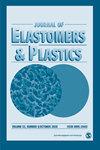Natural Weathering of Poly (Lactic Acid): Effects of Rice Starch and Epoxidized Natural Rubber
IF 1.6
4区 材料科学
Q4 MATERIALS SCIENCE, MULTIDISCIPLINARY
引用次数: 32
Abstract
Poly(lactic acid) (PLA) composites consisting of PLA, rice starch (RS), and epoxidized natural rubber (ENR50) are compounded using a twinscrew extruder followed by compression molding. Two types of thermoplastic starch are prepared by mixing RS with glycerol and water. Natural weathering tests are performed on the PLA/RS composites in Penang, Malaysia for 2 months. The average mean temperature and mean relative humidity are 29°C and 70%, respectively. Tensile tests are performed to characterize the mechanical properties of the weathered PLA/RS composites. Morphological studies are performed by using scanning electron microscopy (SEM). The tensile properties of weathered PLA/RS composites decreased slightly, on the other hand, the tensile properties of weathered PLA/SG and PLA/SGW composites decreased drastically. The retention-ability of the PLA composites are relatively low, which may be attributed to the photo-degradation of PLA, chain scission of PLA, oxidation degradation on ENR, moisture absorption of RS, and leaching of RS particles. In addition, discoloration, surface roughness, surface cracking, and embrittlement are observed for all PLA/RS composites. The extent of degradation is increased by the addition of ENR, owing to the fact that ENR is susceptible to oxygen attack, and consequently facilitates degradation. The morphological properties of the weathered PLA/RS composites are transformed to a more brittle behavior, indicating that severe degradation has occurred on the PLA/RS composites.聚乳酸的自然耐候性:大米淀粉和环氧化天然橡胶的影响
由聚乳酸(PLA)、大米淀粉(RS)和环氧化天然橡胶(ENR50)组成的聚乳酸(PLA)复合材料采用双螺杆挤出机,然后进行压缩成型。通过将RS与甘油和水混合制备两种类型的热塑性淀粉。在马来西亚槟城对PLA/RS复合材料进行了为期2个月的自然风化试验。平均气温29℃,平均相对湿度70%。拉伸试验表征了风化PLA/RS复合材料的力学性能。形态学研究是通过使用扫描电子显微镜(SEM)进行的。PLA/RS复合材料的拉伸性能略有下降,而PLA/SG和PLA/SGW复合材料的拉伸性能则急剧下降。PLA复合材料的保持性较低,这可能是由于PLA的光降解、PLA的断链、ENR的氧化降解、RS的吸湿和RS颗粒的浸出。此外,还观察了所有PLA/RS复合材料的变色、表面粗糙度、表面开裂和脆化。由于ENR易受氧攻击,因此易于降解,因此加入ENR会增加降解程度。经风化的PLA/RS复合材料的形态特征转变为脆性特征,表明PLA/RS复合材料发生了严重的降解。
本文章由计算机程序翻译,如有差异,请以英文原文为准。
求助全文
约1分钟内获得全文
求助全文
来源期刊

Journal of Elastomers and Plastics
工程技术-材料科学:综合
CiteScore
3.30
自引率
5.90%
发文量
41
审稿时长
6 months
期刊介绍:
The Journal of Elastomers and Plastics is a high quality peer-reviewed journal which publishes original research on the development and marketing of elastomers and plastics and the area in between where the characteristics of both extremes are apparent. The journal covers: advances in chemistry, processing, properties and applications; new information on thermoplastic elastomers, reinforced elastomers, natural rubbers, blends and alloys, and fillers and additives.
 求助内容:
求助内容: 应助结果提醒方式:
应助结果提醒方式:


